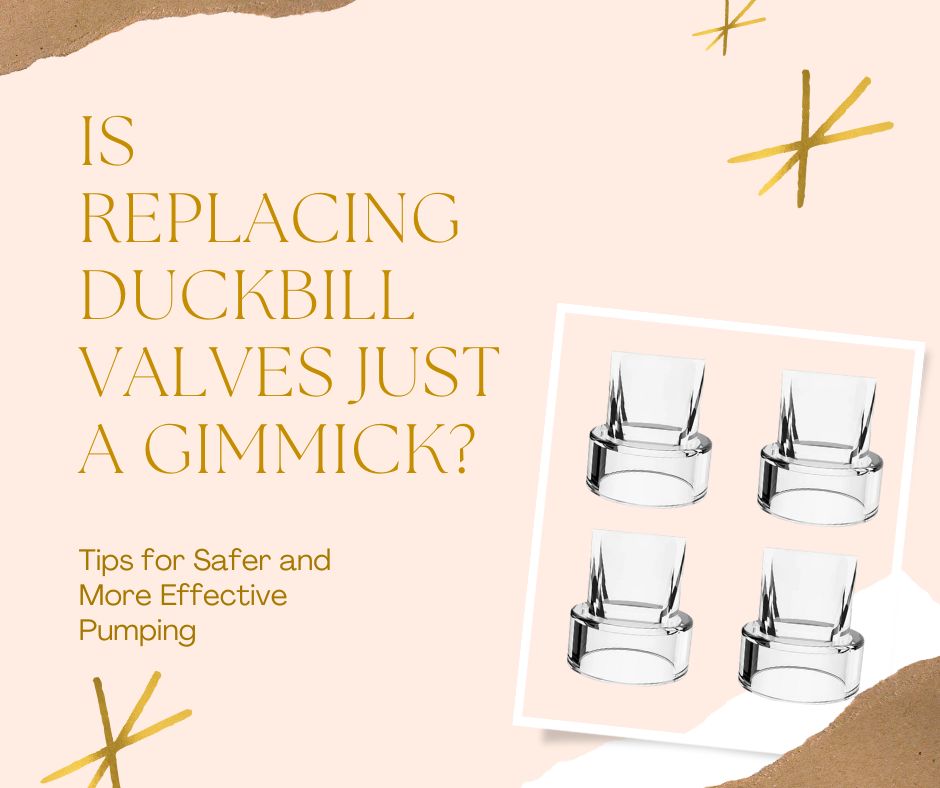
Is Replacing Duckbill Valves Just a Gimmick? Tips for Safer and More Effective Pumping Every Breastfeeding Mom Should Know
Share
Have you ever noticed a drop in your milk output after pumping for a couple of months? Even after trying a different brand, the problem persists?
Before you rush to spend another $100 or more on a new pump, take a moment to check one important thing: when was the last time you replaced your duckbill valve? If it’s been a while, that might be the culprit! Over time, a worn-out duckbill valve can cause milk to backflow, which in turn can cause your pump to malfunction. This is a common issue with all on-the-go electric breast pumps.
So, why is the duckbill valve so important? Let’s take a closer look at this little part that often goes unnoticed but plays a big role in keeping your pump running smoothly.
What is a Duckbill Valve and Why Does it Matter
The duckbill valve is typically made from flexible silicone and functions as a one-way valve. It allows milk to flow out of the breast and into the bottle but prevents milk from flowing back into the pump motor. Over time, this valve can wear out, losing its elasticity and causing problems like reduced suction, milk backup, or even leakage.
How Often Should You Replace Your Duckbill Valve
If you’re using your breast pump regularly, it's essential to replace the duckbill valve to maintain its performance. Based on expert recommendations, here’s a general guide:- Every 1-3 months for frequent pumping: If you’re pumping 3 or more times a day, you should replace your duckbill valve every month to prevent any decline in suction or efficiency.
- Every 2-3 months for occasional use: If you pump less frequently (1-2 times per day), you can extend the life of the valve, replacing it every 2 to 3 months.
Why Do Duckbill Valves Wear Out?
- Elasticity Loss: As the duckbill valve is used, its flexible silicone material can lose its shape. This leads to ineffective suction and, in some cases, milk leaking back into the system.
- Milk Residue Buildup: Over time, milk residue can accumulate, affecting the valve's performance. Even with diligent cleaning, the valve can degrade after prolonged use.
- Frequent Cleaning and Sterilization: Although regular cleaning is essential for hygiene, the process of washing and sterilizing the valve can also cause the material to break down faster.
Signs It’s Time to Replace Your Duckbill Valve
Not sure if your duckbill valve needs replacing? Here are some common signs:
- Reduced suction: If your pump isn't as powerful as it once was, the duckbill valve might be losing its grip on the pump’s efficiency.
- Milk backing up: If milk starts to back up into the tubing or pump motor, it’s likely the duckbill valve isn’t sealing properly.
- Visible damage: Cracks, tears, or warping are clear indicators that it's time to replace the valve.
How to Extend the Life of Your Duckbill Valve
While the valve will eventually wear out, you can take steps to prolong its life:
1. Regular cleaning: Clean your duckbill valve after each use to prevent milk residue from building up. Wash with warm, soapy water, and dry thoroughly.
2. Avoid harsh sterilizing methods: Overheating or over-sterilizing can speed up the degradation of the valve material. Stick to mild cleaning solutions and avoid prolonged exposure to high heat.
3. Inspect regularly: Keep an eye on the valve’s elasticity and overall condition, replacing it at the first sign of wear.
Why Investing in Replacement Valves is Worth It
While the cost of replacing parts like the duckbill valve can add up over time, it's a small price to pay for ensuring the optimal performance of your breast pump. By replacing the valve as needed, you not only maintain proper suction and hygiene but also ensure a more efficient and comfortable pumping experience.As a mom, you deserve the best tools for the job. By staying on top of pump part replacements, you ensure that your breast pump continues to serve you well, supporting your breastfeeding journey with every pump session. Plus, a well-maintained pump means less frustration and more time spent bonding with your little one.
For mothers who depend on their breast pump, it's crucial to keep the duckbill valve in check. Replacing it regularly ensures that both you and your baby get the most out of every pumping session, ensuring that your breastfeeding experience remains as smooth and stress-free as possible.
Happy pumping!
